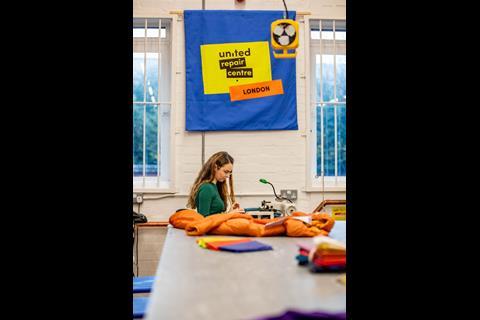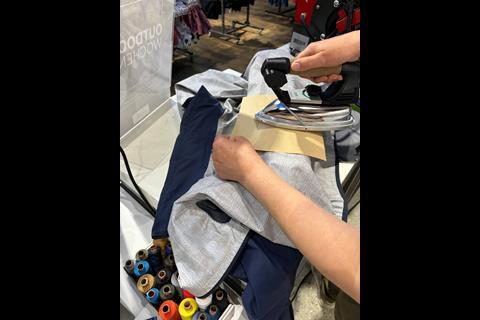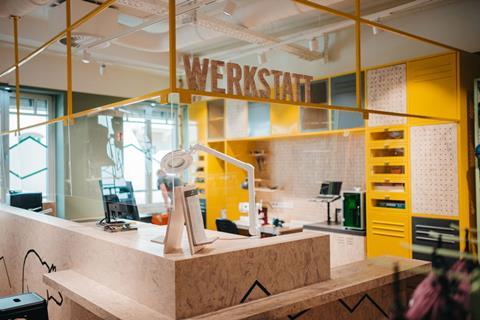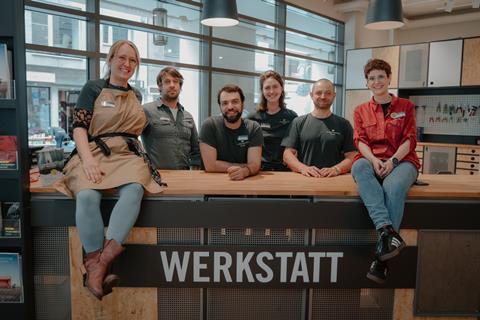Repair services are currently experiencing a revival. Wherever you look, brands and retailers are opening new repair centers, entering new repair partnerships, producing DIY repair guides, adding repair kits to products and expanding their range of spare parts. Of course, these changes are closely linked to consumer and legislative demands. The latter may soon require the textile industry to improve the longevity of its products with repair services. What is happening in this dynamic area, what solutions are companies working with and what role does the customer play?
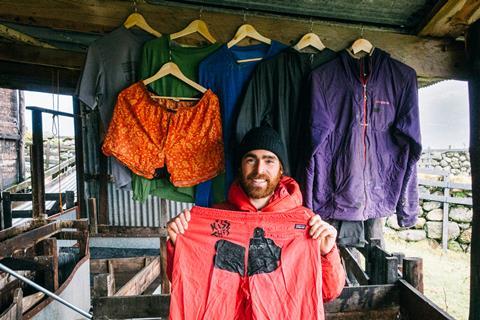
Supply and demand for repair services on the rise
When it comes to repairs, brands with a long history often have an advantage. This is because companies like Schöffel and Lowa have been around for decades, and in the past, it was simply a matter of course to offer customers product repairs in their own production facilities. “Our repair service has been in existence since 1961,” explains Ludwig Schuster, head of the Schöffel Service Factory at the company’s headquarters in Schwabmünchen. “In the past, it was more for reasons of economy, repairing things rather than replacing them, and today it is mainly for reasons of sustainability.” Schöffel also offers repairs in Switzerland and the UK, but these are carried out by local service providers. Although Schöffel has been doing repairs for a long time, the subject is becoming increasingly important. The number of repairs is growing by about ten percent a year, says Schuster. “Last year we had around 4,900 repairs in our service factory, this year it will be around 5,500.”
Retailers have also long since discovered the subject. At multi-brand retailer Globetrotter, the repair service is also growing. “Last year we carried out 33,000 repairs - and the trend is still upwards,” says Christiane Gawlik, Product Lifecycle Manager at Globetrotter. After Globetrotter opened its first repair workshop in Dresden in 2018, 16 other branches have now been equipped with them. There is also a central workshop in Ludwigslust. In the long term, all 22 branches will have their own workshops. New workshop partnerships, such as with Ortlieb and, since August, Vaude, mean that new services are constantly being added to meet the growing demand.
But the potential is even greater: Decathlon Germany alone carried out around 120,000 repairs in 2023 and aims to more than double this figure over the next three years. To this end, Decathlon has opened a new regional workshop in Munich in October 2024. Decathlon has already established a comprehensive repair and maintenance service online and in-store in many markets, offering traditional services such as skate sharpening and bike servicing, as well as more specialized repairs such as replacing broken kayak tubes. The company also has an extensive stock of spare parts for products in almost all sports.
Offer the repair service for free or not?
When it comes to the cost of repairs, there are many different solutions. Since the launch of the Worn Wear program in 2013, Patagonia has offered free repairs. This applies not only to repairs of Patagonia products received through the company’s website and stores, but also to products of any brand that are repaired through the Worn Wear program. Last year, Patagonia repaired more than 23,000 garments in Europe. “The program was created to encourage people to take care of their clothes, wash them regularly and get them repaired,” says Birgit Grossmann, Community Marketing & Impact Manager Central Europe at Patagonia. “We want to make it as easy as possible for our consumers to repair their outdoor clothing.” In Europe, Patagonia works with the United Repair Center in Amsterdam and in London, to perform repairs, and is also looking to expand the service: “The goal is to be able to repair up to 100,000 garments a year by 2028,” says Grossmann. And: Patagonia classifies the repair service as marketing. An indicator that it is a loyalty tool.
Schöffel, on the other hand, has decided against offering free repairs. “We only repair free of charge what is covered by the warranty and goodwill,” explains Ludwig Schuster of Schöffel. However, the company does not pass on the actual costs to its customers, but subsidizes the service “to keep the service attractive”. Price lists on the Internet give customers an idea of what a repair would cost in advance. For example, a new zipper on a jacket costs €53.55. That’s not cheap, but it means that Schöffel can guarantee a faithful repair using original spare parts and professional expertise. “We discussed at length whether we should offer the service for free, but decided against it because there is a business out there that makes a living from it. If we were to repair for free, it would have an impact on others,” explains Schuster.
´→ Challenges that brands face on their road to repair
New service providers emerge: Bundling and scaling after-sales services
The United Repair Center (URC) mentioned above is just one example of how the resurgent repair trend is creating new businesses. The URC was established in Amsterdam in 2022 and has opened another branch in London. The next branch will be opened in France soon. In total, eleven brands already use the URC service. The latest addition is The North Face, “and we will be announcing a number of new partnerships in the coming months,” says Thami Schweichler, CEO of the Repair Center. “This expansion is part of our strategy to increase our reach and impact across Europe and beyond.” In addition to clothing, the center repairs tents, sleeping bags and more. Outsourcing the service and working with the URC creates important synergies. “By working with us, brands can benefit from our expertise in repairs and sustainability without having to invest in their own infrastructure and training,” Schweichler added. “Our focus on high-quality, scalable repair services ensures that brands can efficiently and cost-effectively deliver this valuable service to their customers.”
Efficiency is a key word. Only if labor-intensive services such as repairs or product maintenance can be scaled efficiently can they be offered at the low prices that consumers demand. This was the motivation behind the collaboration between French startup Prolong and ski brand Fusalp, which wanted to professionalize its repair service with the help of newly developed B2B software. Prolong’s new software helps brands offer cost-effective after-sales services across all their sales channels - in their online shop, in stores and with their wholesale partners - and in all markets. Prolong not only digitizes the processes, but also connects the brands with the appropriate workshops that can carry out services such as repairs, alterations, maintenance or personalization. Launched just over a year ago, the software is already live with several brands and in many countries. “With Prolong, brands can now offer repairs either through local partners or through national partners. Together with the brands, we offer customers a solution to problems they previously had to solve on their own because the service was not available from the brands,” says Prolong co-founder Christina Schwarzkopf.
After-sales services as a revenue driver?
Prolong goes so far as to say that services such as repair, maintenance and even customization have the potential to generate new revenue. “Brands can sell their customers not only products, but also services, in all channels before and after the sale,” she says. To date, brands have offered these services primarily for warranty cases, but with consumers’ new awareness of sustainability, brands could also introduce fee-based services that help consumers care for their products and extend their useful life. With after-sales services, brands could unlock new revenue potential, as “circular services in the fashion market are growing faster than the fashion market itself - by about 20 percent by 2030. They are therefore exciting growth areas for apparel companies,” says Schwarzkopf.
More services for more loyalty
Above all, after-sales service has enormous potential for customer retention. “Repair and maintenance services increase brand loyalty, demonstrate a commitment to sustainability and can attract environmentally conscious consumers, thereby increasing overall sales,” says URC’s Thami Schweichler. Modern brand experiences, such as Dynafit’s recently opened “Speed Factory” near Munich, can no longer do without a repair center.

Retailers appreciate repair campaigns
Schöffel also sees a lot of potential in this as a marketing issue, which is another reason why it subsidizes this service. “With this service, we are increasing the number of contact points with our customers and regularly receive good feedback. We are actually becoming a problem solver for them,” says Ludwig Schuster of Schöffel. That’s why the company is now actively using the topic in its communication with retailers and consumers. Just a few weeks ago, Schöffel launched a repair tour through Germany in cooperation with six retailers to repair customers’ clothing. The retailers were very interested in this campaign. Schuster: “Retailers are always happy when they can offer attractions on the sales floor. We actually had to do a lot of curating and could have made many more stops.” He sees more potential in the service as a marketing tool, but not as a profit center. The service is too costly for that. Schuster: “If you go as far as to make it a profit center, there are only two options: either you become more expensive or you reduce costs by outsourcing. We don’t see either of those happening at the moment. “It’s more about customer loyalty and creating an experience for the customer. After all, there is nothing more powerful than solving a problem together!”
Is your brand ready for the sustainable consumer?
Eco-conscious consumers are reshaping the sports and outdoor industry. Discover the latest trends and strategies to stay ahead in our special series.
>> Find out more

